Bullfrog Gold Corp.
(OTCQB: BFGC) |
September 13, 2016 |
Finding Gold in Nevada by Looking
Where It's Been Mined Before
Bullfrog Gold Corp. Compiles 470,000 oz. Gold Inventory Left Behind by Barrick's Bullfrog Subsidiary
This report will introduce
you to Bullfrog Gold Corp. (OTCQB: BFGC), a gold exploration and
development company started in 2011 with a gold project that is 120
miles NW of Las Vegas, Nevada. The company is dedicated to proving the
maxim that if you want to find gold, the best place to look is where it
has previously been found.
Located within the prolific
Walker Lane Mineral Trend and only 4 miles west of the town of Beatty,
Nevada, this gold mining area produced 2.3 million oz gold averaging
0.08 oz/t for Barrick Gold. Here, Barrick, et al, conducted major mining
operations between 1989 and 1999.
Barrick's mines included
the major Bullfrog pit (1.1 mil.oz @ 2.5 g/t gold), the underground
Bullfrog mine (690,000 oz. gold @ 7.5 g/t), and the Montgomery-Shoshone
pit (M-S) which yielded 220,000 oz gold @ 2.2 g/t gold. (See area maps
below.)
Our own company, Bullfrog
Gold Corp, began exploring this area in 2011 with the acquisition of its
initial land position of 79 claims and two patents located immediately
east and north of the Bullfrog and M-S open pit mines. Subsequently, the
company optioned from another land owner 12 additional land patents
that were previously leased by Barrick. These patents cover the NE half
of the M-S pit and significant exploration areas north and south of the
M-S pit. The company also leased and optioned from Barrick 28 claims and
6 more patents, two cover the SW half of the M-S pit and the balance of
lands cover the northern third of the original Bullfrog deposit. Today,
the company controls the entirety of the M-S, the northern third of the
Bullfrog pit and all the area underground mined by Barrick, plus
prospective lands to the east and north.
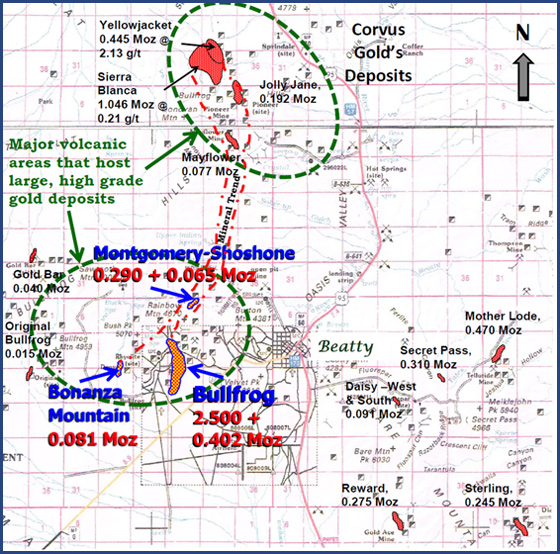
Gold Deposits in the Beatty Area
(M-S and Bullfrog includes Barrick + BFGC Estimates)
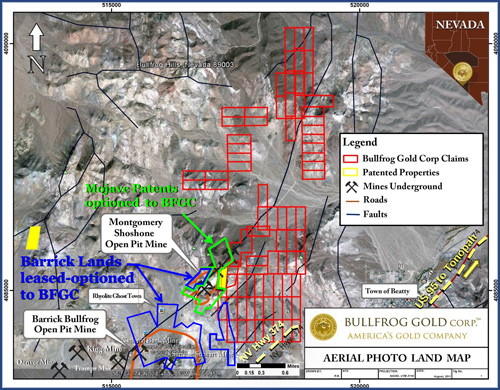
In all, the company now
holds 2,200 acres here, including 99 federal lode claims, 20 patented
claims and 8 mill site claims. Additionally, the company has identified
significant additional mineralization and further exploration potential
which has been based on an intensive study of Barrick's electronic and
paper data bases. This data includes 157 miles of drilling in 1,298
drill holes, as well as more than 2,500 pounds of paper documents.
Today, all this data would cost more than $40 million to re-create. This
study yields some surprising results in terms of showing strong
potential for additional gold content throughout this area.
It is noted that Bullfrog
Gold is the only one to examine the electronic and paper data bases
after they were shipped offsite in 2000; and is the only entity to
thoroughly evaluate the mineralization remaining around and under
Barrick's Bullfrog and M-S pits and between the Bullfrog pit and
underground mine.
Current Gold Inventory Estimated at 470,000 oz. Gold
The Company has analyzed
and estimated the remaining mineral inventories of gold around the
Montgomery-Shoshone and Bullfrog mines at 470,000 oz. gold as summarized
below:
| Mineral Inventory Estimates: |
| Pit Areas |
Tonnes Millions |
Gold G/T |
Gold Ounces |
| M-S Shallow |
1.1 |
1.06 |
38,612 |
| M-S Deeper |
0.9 |
0.93 |
26,813 |
| Bullfrog North |
13.3 |
0.88 |
375,051 |
| BF NE Mystery Hill |
0.9 |
0.80 |
26,813 |
| |
| Total/Average |
16.4 |
0.89 |
469,961 |
|
The estimated mineral
inventory was calculated by the company at an average of 0.89 g/t using
manual cross-sectional methods and a nominal cut-off grade of 0.3 g/t.
This cut-off grade is higher than most heap-leach projects now operating
in the USA, suggesting that this area can be re-opened for productive,
low-cost heap-leach processing. The above estimates are strongly
supported by the close-spaced Barrick drill holes where 2.3 million oz
gold were recovered.
The company believes the
mineral inventory estimates can be readily and inexpensively upgraded
with minor additional drilling to comply with US and Canadian estimation
standards, as well as defining several additional exploration targets
which can expand overall gold mineralization in the area.
M-S Pit Area:
In addition to
mineralization immediately around the M-S pit, there is only one hole
located within 150 meters from the NE pit limit and the next hole is
1,000 meters NE. Furthermore, these mineral trends and structures have
been projected more than 4 km NE of the M-S pit, but only eight holes
were drilled by Barrick in this large area.
Located east of the M-S pit
area is an area that is 700 meters by 1,300 meters, but it contains
only one shallow old hole from which no data is available. Only a
portion of this area may be prospective, but additional study and
exploration drilling is warranted. The adjacent lands east and north of
this area also have limited drilling. The company now controls all the
lands that cover the M-S pit.
Bullfrog Pit and Underground Mine Area:
From 1989 through 1994
Barrick recovered more than 1,346,000 ounces by conventional milling of
Bullfrog ores using a pit cut-off grade of 0.5 g/t. From 1992 through
1998 approximately 690,000 ounces averaging 0.24 opt were recovered from
the north extension of the deposit and below much of the Bullfrog pit
using underground mining and a cut-off grade of 3 g/t. As a result,
significant mineralization grading from 0.2 to 3.0 g/t remains between
the pit and underground workings and in isolated high-grade intercepts
that were too small or distant to develop and mine underground. Since
Barrick's underground operations extracted 95% of their reserve, it is
expected that an additional 5% or 34,000 ounces averaging 0.24 opt
remain around the underground workings that are not included in the
company's estimates. Half of this high grade may be within pit mining
depths. Most of Barrick's Bullfrog production was from lands now
controlled by the company.
The Mystery Hill structure
is northeast and adjacent to the main Bullfrog deposit and has shallow
mineralization for a known strike length of 300 meters. This area only
contains 6 interior drill holes and has not been adequately drilled to
estimate deeper potential down-dip or expanding mineralization along
strike.
Metallurgy:
Heap-leach tests by Barrick
and others show very good gold recoveries. Pilot heap-leach tests
performed by Barrick in 1995 on 844 tons crushed to 1/2-inch size
averaged 0.019 gold opt and recovered 67% of the gold in only 41 days
while cyanide and lime consumptions were exceptionally low. Finer
crushed materials yielded gold recoveries up to 75%. Barrick did not
have lower cost heap-leaching facilities and used cut-off grades of 0.5
g/t for pit ore and 3.0 g/t for underground ore.
In 1986, St. Joe Minerals
column-leached a 22-ton composite of minus 12-inch material grading
0.037 gold opt to simulate heap leaching material at a coarse
run-of-mine size and recovered 49% in 59 days of leaching, which they
projected to 54% for leaching 90 days. As a result, much additional gold
could be recovered by run-of-mine heap leaching mineralization less
than 0.3 gram per tonne and thereby further increase mineralization and
enhance project performance.
Excellent Infrastructure:
It should be mentioned that
project infrastructure and attributes include water rights to the
entire area including the Bullfrog and the M-S mines area, a
high-voltage electrical power line and substation site installed by
Barrick, as well as a nearby town less than 4 miles away that hosts a
population of 1,000 with associated amenities and services. A paved
state highway crosses the southern property boundary, plus suitable
access roads remain throughout much of the property. Pit ramps remain in
excellent condition. Pit walls are stable up to 53 degrees, thus the
ultimate amount of waste that must be removed with the resumption of
mining will be significantly less than pits that require flatter slopes.
It should be noted that
haulage ramps from the surface to the pit bottoms all remain in place
thereby allowing expansion of the M-S and Bullfrog pits while minimizing
costs, particularly up-front. Furthermore, nearly all waste produced
from the Bullfrog and M-S pits could be sequentially back-filled in the
large Bullfrog pit. This would significantly reduce waste haulage costs
while also avoiding additional large waste dumps which would have
associated environmental impacts and costs.
Strategic Land Acquisitions:
As reported above, the
company acquired three strategic land positions in the Bullfrog Mining
District which include the entire Montgomery-Shoshone deposit and the
northern one-third of the main Bullfrog deposit where Barrick mined
approximately 2.1 million ounces by open-pit and underground methods. In
addition to prospective adjacent lands, these acquisitions contain
significant remaining ounces of gold and provide the potential to expand
both deposits along strike and at depth.
Details of these acquisitions are as follows:
The initial holdings of 2
patents and 79 lode claims were purchased on September 29, 2011. The
Company issued 14.4 million shares of BFGC and granted a production
royalty of 3% NSR on the property plus an aggregate 3% NSR cap on any
acquired lands within one mile of the 2011 boundary. Thus, the original
owner would not receive any royalty on acquisitions having an NSR of 3%
or greater.
Twelve contiguous patents
that include the northeast half of the M-S pit were optioned to purchase
on October 29, 2014 from a private company based in Salt Lake City. The
seller was paid $16,000 plus 750,000 shares of Bullfrog common stock on
closing and, to earn a 100% interest, is scheduled to be paid $200,000
over nine years while performing no less than $100,000 of work per year
for five years on or within 1/2 mile of the 12 patents. The selling
company retained a sliding scale Net Smelter Return royalty ranging from
1% for gold prices below $1200/ounce and up to 4% for gold prices above
$3,200 per ounce. For reference, Barrick terminated a lease on these
patents after they ceased operations in late 1999.
Bullfrog's Lease with Barrick:
Bullfrog's lease and option
with Barrick was signed on March 23, 2015 and includes 6 patents (two
of which cover the southwest half of the M-S pit); 20 unpatented claims
that cover the northern one-third of the main Bullfrog deposit and 8
nearby mill site claims. Bullfrog has access to Barrick's substantial
data base within a 1.5 mile radius of the leased lands to further
advance its exploration and development plans and programs. The lease
and option also includes all Barrick's water rights appurtenant to the
property. To maintain the lease and option, Bullfrog must spend $1.5
million within five years on the Barrick properties and then pay Barrick
3.25 million shares of Bullfrog stock while providing a 2% gross
royalty on production from the Barrick properties.
Overriding royalties of 5%
gross proceeds are limited to three claims and two patents in the main
Bullfrog pit area. Barrick has retained a back-in right to reacquire a
51% interest in the Barrick properties, subject to definition of a
mineral resource on the Barrick properties meeting certain criteria, and
reimbursing Bullfrog in an amount equal to two and one half times
Bullfrog's expenditures on the Barrick properties.
For reference, Barrick
terminated all mining and milling operations in 1999 when gold prices
averaged less than $300 per ounce for the year and reached a low of
$258/oz. in August 1999. The company as a result is well positioned to
explore such opportunities for the expansion of its mineral inventory. A
patented claim on the east and north limits of the M-S pit is owned by
the company, but Barrick never controlled or had access to that patented
claim. The economic margins for heap leaching lower grades at current
gold prices near $1330/oz are deemed much better than in 1999.
A series of corporate
takeovers changed the land ownership of the area originally from St. Joe
Minerals to Bond Gold, to Lac Minerals, and eventually to Barrick, who
folded its tents in 1999. Modern production here started in 1989 and
recovered approx. 2.3 million oz. gold from a conventional,
9,000-tonne/day cyanidation mill mainly fed from open pit mining, but
significantly supplemented from mining underground ores that averaged
0.24 ounces gold per ton.
Beneath the M-S Pit:
Bullfrog management has
estimated that 38,612 ounces of gold in 1.1 million tons of material
averaging 1.06 grams per ton remains within the shallow zone under the
existing M-S pit. An additional 26,813 ounces of gold averaging 0.99
gram per tonne remain in the deeper zone under the M-S pit. These manual
estimates were based on cross sections typically spaced 15 meters
apart, a nominal cutoff grade of 0.3 gram gold per ton at the top and
bottom of mineral intervals, and drill data and pit surveys completed by
Barrick.
Half of this M-S
mineralization is on two Barrick patents within the pit and half is on
two of the 12 other patents. The ratio of waste to mineral tons within a
cross-sectional preliminary pit outline of the shallow estimate is
1.06:1 and the ratio for the overall estimate is 2.55:1. Additional
drilling is required to test further down dip extensions of
mineralization in the M-S area.
Significant drilling is
required to test projections of mineralized trends and structures that
extend for considerable distances to the north and east of the M-S pit
on the original lands acquired by Bullfrog in 2011. Located east of the
M-S pit is an area 700 meters by 1,300 meters in which there is only one
shallow hole from which there is no data available. Only a portion of
this area may be prospective, but it certainly warrants additional study
and exploration drilling.
There is only one drill
hole located about 150 meters NE of the M-S pit limit and another hole
1000 meters NE of the pit along strike of a major geologic structure. In
this regard, Bullfrog's lands extend nearly 5,000 meters NNE of the pit
and there has been very little drilling in this area, even though
several structures have been mapped by Barrick and others. This
situation suggests the potential for substantial additional gold
mineralization to be discovered in this area.
To Depth:
Barrick drilled twelve deep
holes in the M-S area, ranging from 318 meters to 549 meters deep, and
these also suggest the potential expansion of the mineral resources.
Notable mineral intercepts from four holes below the central part of the
pit are summarized below:
| Hole No. |
Intercept Data, Meters |
Gold G/T |
| Thickness |
Under Pit |
| 717 |
51.8 |
70 |
1.35 |
| 18.3 |
135 |
0.59 |
| 15.2 |
150 |
0.68 |
| *160.0 |
180 |
0.96 |
| 732 |
10.7 |
200 |
0.84 |
| 79.2 |
330 |
0.74 |
| 733 |
12.2 |
130 |
1.14 |
| 13.7 |
220 |
0.75 |
| 29.0 |
250 |
0.70 |
| 734 |
4.6 |
15 |
6.03 |
| 21.3 |
70 |
1.43 |
| 22.9 |
130 |
0.89 |
| 4.6 |
190 |
1.04 |
| |
| * 525 feet averaging 0.028 Au opt, includes 70 feet at 0.061 Au opt |
|
These
results demonstrate that substantial amounts of gold occur in this
exceptionally large epithermal system that has good potential for
expansion and possibly higher grades at depth. Note that four of these
intercepts are less than 75 meters below the existing pit. Two holes
located 40 meters and 90 meters east of the 160 meter interval in hole
#717 contained no significant mineralization at this depth, whereas the
29 meters of minerals in hole #733 is 60 meters west and the mineral
zone is open to the north, south and west.
In summary, Bullfrog Gold
looks forward to adding shareholder value through exploring its expanded
land position while building mutually beneficial business relationships
with Barrick and other stakeholders in the area.
Management & Geological Team for Bullfrog Gold
David Beling – President and CEO,
is a Professional Mining Engineer with 52 years of experience,
including engineering, permitting, financing and management of 12 open
pit mines, 9 underground mines, 14 process plants and building of
several corporations. His career initially included 14 years of
employment with Phelps Dodge, Union Oil, Fluor, United Technologies and
Westinghouse, then 38 years of project and executive management and
senior consulting with 25 junior US and Canadian base and precious metal
mining companies. During 2006 and 2007 he spearheaded an IPO, drove
three equity raises totaling C$ 112 million and grew the company's
market capitalization to US $460 million. Mr. Beling has served on
fourteen Boards since 1981, including three mining companies
distinguished by Canada's TSX Venture Exchange as top-10 performers.
Beling also has extensive heap leaching success and performance in
Nevada and drove the approval of the first Environmental Impact
Statement approved for a mine in Arizona.
Beling is the mastermind behind the expansion of Bullfrog Gold in the area described above.
Other Management
Alan Lindsay – Chairman.
40+ years of experience as a businessman, including 25 years in the
mining industry. Developer and founder of several public companies.
Tyler Minnick, CPA – Director Administration & Finance. 22 years of experience in accounting and auditing with public and private firms.
Clive Bailey, CPG – Lead Geological Consultant – Klondike Project. 42 years of experience with exploration, development and mine operations.
Joe Wilkins – Sr. Geological Advisor. 49 years of experience. Discovered 2.7 MM ounce Bullfrog deposit mined by Barrick.
Outlook for Bullfrog Gold
Bullfrog seems to be firmly
launched on the plan to upgrade its 470,000 oz. gold inventory to meet
and comply with US and Canadian resource standards. But there is also a
tremendous amount of exploration potential beyond this, as already noted
in this report. The company would not say so, but it is obvious that
there is a potential here for more than 1 million oz. gold. We look
forward to seeing the next leg of development here.
Bullfrog recently reduced
its debt from $3.0 million to less than $300,000. In summary, the
following table shows the company is significantly undervalued compared
to six peer companies, thereby providing an exceptional opportunity for
investment.
| Company & Project Comparisons |
| As of August 17, 2016 |
Exchange rate = C$ 1.286 |
|
| Company |
Project |
Meas.+Ind. Res. |
Mark. Cap
$ x MM |
Market Cap.
$ / Oz. M&I |
MT
x 1000 |
Oz. Gold
x 1000 |
| Corvus Gold |
North Bullfrog (1) |
28.8 |
628 |
82.0 |
130.57 |
| Pershing Gold |
Relief Canyon |
37.3 |
739 |
107.4 |
145.33 |
| West Kirkland |
Hasbrouck/3Hill |
65.1 |
927 |
36.1 |
38.94 |
| Northern Vertex |
Moss Mine |
15.5 |
377 |
32.7 |
86.74 |
| Otis Gold |
Kilgore |
27.3 |
520 |
24.2 |
46.54 |
| Waterton |
Mt. Hamilton (2) |
33.7 |
828 |
30.0 |
36.23 |
| |
| Averages |
35 |
670 |
30.0 |
77.73 |
| Bullfrog Gold |
Bullfrog (3) |
16.4 |
470 |
11.7 |
24.89 |
(1) Excludes 135 mm t of inferred resources at 0.2 g/t
(2) Mt. Hamilton sold in 2015 for $30 million before prices increased substantially
(3) Assumes mineralization is M & I. Excludes inferred and exploration potential |
|
We recommend that readers consider taking a position in Bullfrog Gold, which is traded on the OTCQB under the symbol of BFGC.
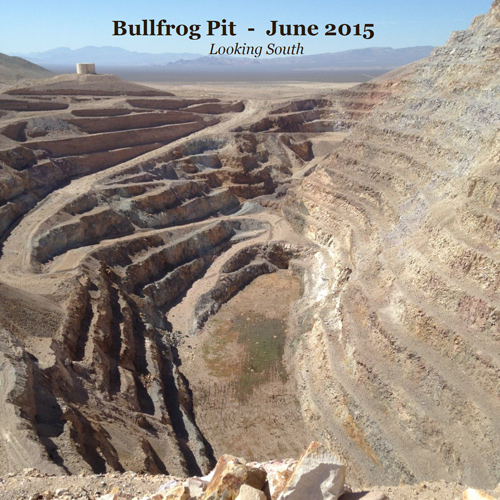
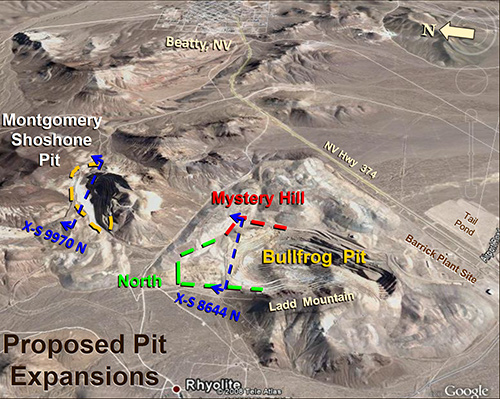
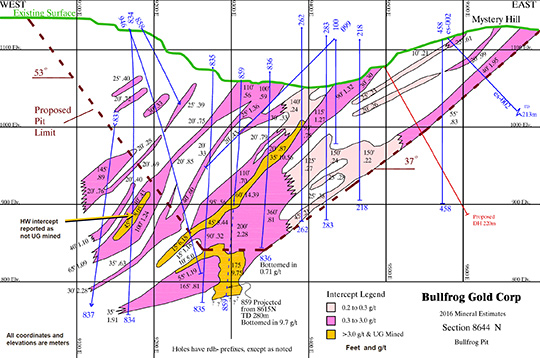
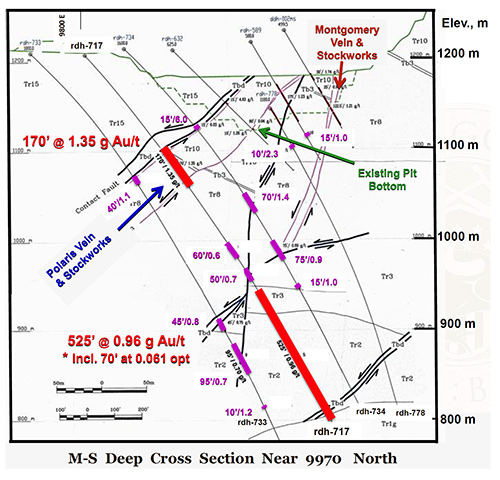
|